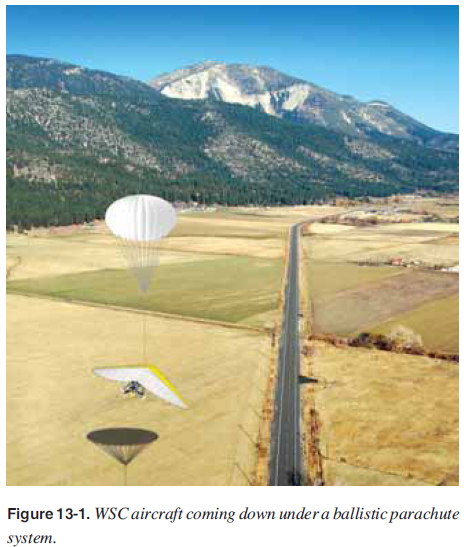| CHAPTER 12. Night Operations
Ballistic Parachute System (BPS)
The ballistic parachute system (BPS) provides an additional
safety margin to fl ying WSC aircraft. However, if utilized
when other alternatives would produce a better outcome or
if not deployed with the proper procedures, BPS system use
could create a worse situation than not using a BPS. The BPS should be used only as a last alternative and only after other
options have been evaluated through ADM. [Figure 13-1]

The choice of adding a BPS as an additional system for
emergencies is up to the pilot. This decision should be made
by evaluating the disadvantages of an additional system, its
advantages, and the situations in which the system would
be utilized.
Advantages of a BPS:
- BPS can be used if there is a total loss of control of the
WSC. The term “loss of control” is key to when the
BPS should be deployed. Always fl y the aircraft fi rst,
but if the pilot cannot control or regain control of the
aircraft (loss of control), this is when the BPS should
be used. Loss of control might result from midair
collisions or wake tip vortices with other aircraft.
A loss of control could also result from structural
failure due to inadequate prefl ight or lack of proper
maintenance.
- BPS can be used if the engine quits and there are no
suitable landing areas. Although pilots try to have a
suitable landing area within gliding distance, there are
times when a parachute could be used with an engine
failure, such as over high trees.
- Pilot incapacitation is a situation where the BPS could
be used. This could be a pilot-in-command (PIC)
illness, such as a heart attack, or an external factor,
such as a bird strike in the face temporally blinding
the pilot. For example, if the pilot is incapacitated by
a bird strike, the pilot could feel for the handle and
pull it. Other designs allow the pilot and passenger
to be able to reach and actuate the BPS, while other
designs have two separate handles for the pilot and a
passenger. Many passengers feel safer if they know
they can actuate the BPS if the pilot is unable to fl y
the aircraft.
- Pilot disorientation with loss of control of the
aircraft is a situation where the BPS could be used.
In the unusual situation of severe vertigo or spatial
disorientation preventing the pilot from differentiating
up from down, such as severe turbulence, night fl ying,
or fl ying into bad weather, a BPS could be used.
Attempts should always be made to regain composure;
if attempts fail, then the BPS is an option.
Disadvantages of having BPS:
- It provides a false sense of security. A pilot might
believe that the BPS can save him or her from
hazardous situations, which could cause the pilot to
develop hazardous attitudes, exceed limitations, and
make bad decisions.
- The pilot could deploy the parachute when it is not
needed. A BPS should be utilized only as a last
alternative to normal emergency procedures. It should
not be used when ADM produces a better alternative
for the situation at hand.
- • BPS systems installed on a WSC aircraft have greater
initial cost, maintenance, and weight.
- A BPS can be deployed accidentally. This can happen
when the actuation handle is not properly placed, or
when deployed by occupants not following appropriate
procedures.
- BPS systems may not fi re or could tangle during the
deployment. Like any system, it can fail or not be
operated properly, so there is no guarantee it will
fi re or deploy properly. However, if it is mounted,
maintained, and operated properly, the chances of a
successful deployment are good.
The BPS should not be used in abnormal or emergency
situations, such as engine failure when suitable landing areas
are within gliding distance. Other situations in which to avoid
using a BPS are during strong winds/convection/turbulence,
or if lost. Alternatives and greater detail is presented for these
situations where a BPS is not used later in this chapter .
|

